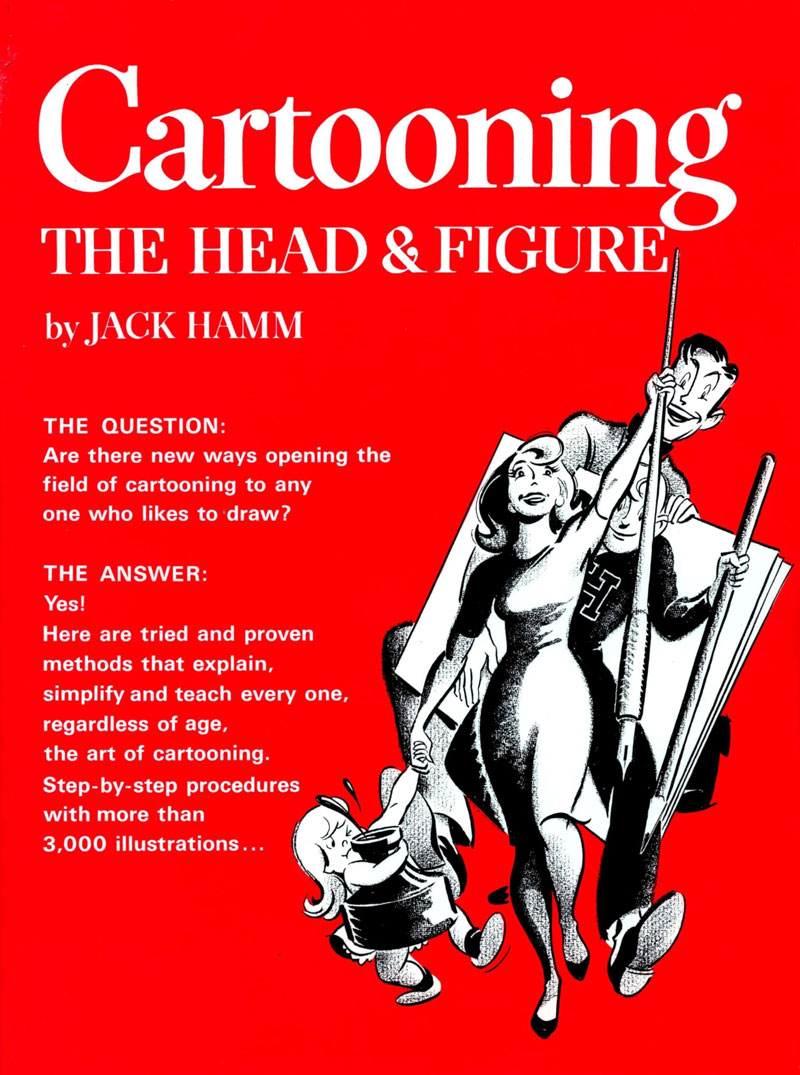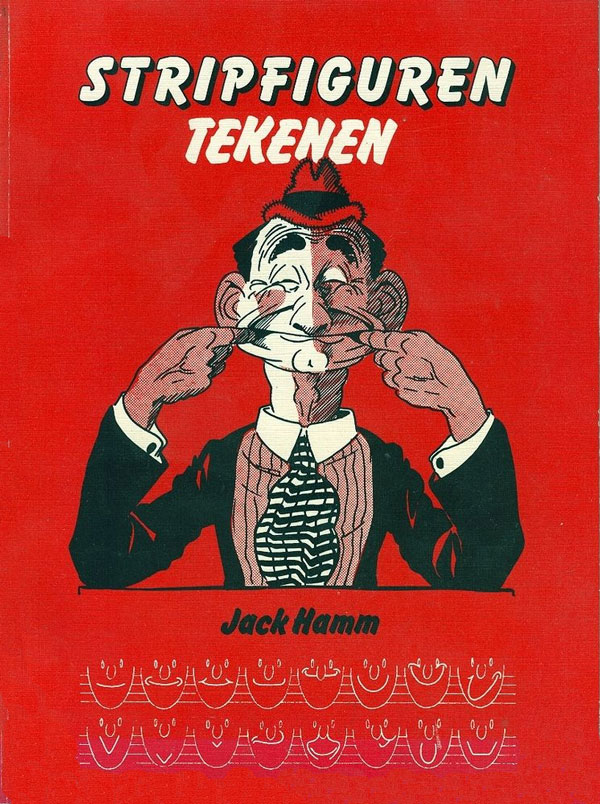Christian comics by Jack Hamm.
Jack Hamm was a mid- to late-20th century American cartoonist, who made Christian-themed artwork and editorial cartoons. He holds historical significance for being the first known comic artist to host an educational TV show about cartooning, 'The Jack Hamm Show', even if this specific program was only broadcast in his home state. Hamm is nowadays perhaps best remembered for his drawing instruction books, like 'Drawing the Head and Figure' (1962), 'Cartooning the Head and Figure' (1967), as well as 'How to Draw Animals' (1969) and 'Drawing Scenery: Landscapes and Seascapes' (1972). Many post-World War II cartoonists have used his books as guidelines.
Life and career
Jack Beaumont Hamm was born in 1916 in Elkhart, Kansas, as the son of a clothing store salesman. After high school, Hamm attended the Moody Bible Institute in Chicago, while between 1936 and 1937, he was also a student at the Frederic Mizen Academy of Art in Chicago. He also preached in small Baptist churches in Kansas and in and around Chicago. In 1943, he got married and moved to Dallas, Texas. During World War II, Hamm fulfilled his military service in Alaska and the Aleutians. Back in civilian life, he went to study theology at Baylor University in Waco, Texas, and additionally taught nine commercial art classes at the same university, and served as interim director of Baylor's art department. After earning his Bachelor of the Arts in 1948, Hamm additionally taught art at Dallas Baptist University. From the 1950s on, he was most notable as a creator of Christian-themed cartoons, his own TV show 'The Jack Hamm Show' and his numerous drawing instruction books. Hamm died in 1996 in Dallas, Texas, at age 80.
Career as a ghost artist
In the early 1940s, in need of money, Hamm turned to cartooning. He assisted as a ghost artist and letterer for the Newspaper Enterprise Association and the John F. Dille Company on newspaper comics like 'Bugs Bunny' (based on Tex Avery's character), V.T. Hamlin's 'Alley Oop', Dick Calkins' 'Buck Rogers', Edgar Martin's 'Boots and Her Buddies' and Albert Edward Wiggam & Raymond Flanagan's 'Let's Explore Your Mind' (1940-1944). Other artists who worked on 'Let's Explore Your Mind' were Richard Doxsee, Rick Yager and Bill Lignante (from 1962 on). Hamm was listed as a cartoonist with the Newspaper Enterprise Association. According to a 14 August 1949 newspaper article in the Dallas Morning News, He is said to have also ghosted on the comic series 'Story of the Stars', 'Red Ryder' (originally created by Fred Harman), 'Major Hoople' (a spin-off of Gene Ahern's 'Our Boarding House') and 'Out Our Way' (originally created by J.R. Williams).
Sequential sample from 'Cartooning the Head and Figure'.
The Jack Hamm Show
From 1949 on, Hamm was the host of one of the first TV shows about art and drawing, called 'The Jack Hamm Show', broadcast on the local TV station KBTV in Texas. He drew caricatures, sometimes in the form of a viewers' contest where they had to "name the face". Sometimes he simply drew for a few minutes, accompanied by background music. He picked out a popular song or classical melody, while making an entire drawing within the timespan of the recording and putting down his panel after the final note had played.
Along with Roy Doty, Hamm was one of the earliest known comic artists to host a drawing show on television.
Drawing old age, according to Jack Hamm.
Religious cartoons
Hamm eventually combined both his callings, and started making religious cartoons for the Baptist Standard of Texas. He also returned to preaching, but this time with the aid of pencil and paper. He sent his Gospel cartoons and illustrations to magazines like Time and Newsweek free of charge through Religious Drawings Inc., the company he ran with his wife Dorisnel. According to an article in the Omaha World-Herald Magazine (6 July 1952), Hamm's cartoons were published on Sundays and also sold to foreign publications.
Drawing instruction books
Jack Hamm's most lasting legacy has been his drawing instruction books. He published several titles, mostly published by Perigree Trade: 'Cartoons That Live' (1954), 'Kompass' (1955), 'The Living Sculptures' (1958), 'He Will Answer' (1961), 'Drawing the Head and Figure' (1962), 'Cartooning the Head and Figure' (1967), 'Drawing Toward God' (which had a foreword by Charles M. Schulz, 1968), 'How to Draw Animals' (1969), 'Drawing Scenery: Landscapes and Seascapes' (1972) and 'First Lessons in Drawing and Painting' (1976). Hamm's instruction books offered valuable tips and tricks on how to master the art of cartooning. He shows off his graphic skills by easily switching between comical drawings and more realistic drawings, while explaining the use of various techniques and styles. Instead of just focusing on "wacky" characters, Hamm also gives interesting advice on how to tackle challenging subjects, like caricaturing celebrities with faces "too pretty or handsome" to properly exaggerate, or on how to suggest crowds of people without necessarily individualizing each and every one of them.
'Cartooning the Head and Figure' (1967): English and Dutch edition.
Hamm's drawing guides have also been translated into many languages and have been reprinted many times. Many future professionals have used Hamm's books as personal instruction manuals, including Milton Knight. In Volume 3 (January 1975-December 1982) of 'Robert Crumb's Sketchbook', two pages worth of Robert Crumb copying sketches from Hamm's 'Cartooning the Head and Figure' can be seen. In a 1993 interview by Jamie Angell for Simpsons Illustrated, Matt Groening explained that Hamm's 'Cartooning the Head and Figure' demonstrated to him "that you can evoke all sorts of emotions with the crudest little ink squiggles." When Chester Brown drew his graphic novel 'Louis Riel' (2003), he said the horses in the story were influenced by the way they are drawn in Hamm's 'How to Draw Animals'.
Illustrations
Hamm also illustrated John W. Drakeford's 'Pornography: The Sexual Mirage' (1973), Emil Gaverluk's 'Did Genesis Man Conquer Space' (1974), James R. Adams' 'I Golgotha' (1987) and Alexandria Uriel's 'Robed in Light' (1990). He was additionally the editor of Peter Marshall's 'Lasting Prayers' (1969).








